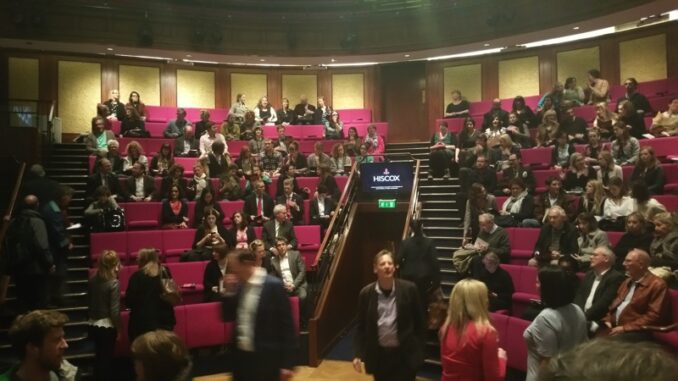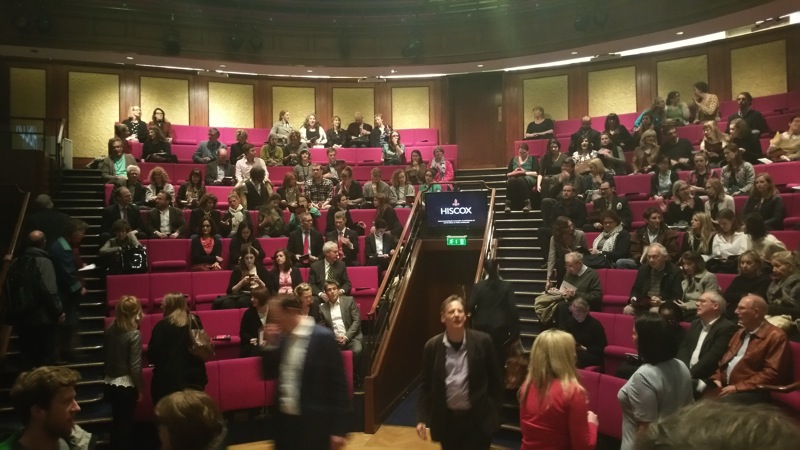
The guest panel is prestigious. The facilitator is Mark Lawson, esteemed journalist, broadcaster and author. The room is filled with a mixture of conservators, suits and students all wondering who else is assembled in the auditorium at the Royal Institution. The debate? The conservation of art and its challenges. Questions open to discussion include, who is morally responsible for contemporary art? And where is the value in contemporary art?
With the debate running a couple of minutes late I glance at the door waiting for a sign of commencement. I see (because you can’t miss it, especially among the conservative suits and shirts) a pink knitted jumper. That’s the sign needed. The proud owner of the jumper is one of the panel: artist Gary Webb. The panellists take their seats and include: Sir Christopher Frayling, Professor, Chair of Arts Council England and the Design Council, Trustee of the V&A Museum, curator, historian, writer and broadcaster. An expert in art and his achievements too long to list but his knighthood in 2000 was for his services to art and design education; Robert Hiscox, Honorary President of Hiscox and contemporary art collector; Kenny Schachter, writer, curator, lecturer and dealer and Sandra Smith, Head of Conservation at the V&A Museum.

Gail Cardew, Director of Science and Education at the Royal Institution takes to the floor with a brief introduction explaining that the Institute was built to allow us to think more deeply about science. It has become a platform for leading thinkers including a talk by Grayson Perry on identity. Now art and science unite to discuss the conservation of art.
A short film opens the debate where we observe two people discussing art. The first explains the changing market and popularity of contemporary art since 2003 while the second is more concerned with the conservation and repair of art and the conflict present in living artists because they can ‘fix’ their damaged work. There is a question on the value after an artist’s death – the market doesn’t know how to respond to that.
This film reminds us of the financial and conservatory aspects to art production making us consider whether the artist is responsible for creating art which endures the test of time and also if they are responsible for the work after sale or creation.
The work specifically discussed today is contemporary art, meaning work produced by artists born after 1945.
One of the major questions underlying this whole debate is responsibility. Whose responsibility is it to conserve? Do we care? Should we care? Fraying states that, ‘Artists, young students, have enough on their minds without worrying about materials and preservation.’ This statement is echoed in the response by all throughout the whole debate – artists’ creativity should not be stifled. Yet, how does one conserve when artists seem to have little scientific knowledge when it comes to material properties? Webb acknowledges there is a difference in how he creates depending on whether his work is a sculpture for the public or a private piece. He is aware of the expectations of longevity and also says he would consider repairing if asked to. Hiscox is definite it’s an artist’s responsibility to fix work.
Conservation of work which is supposed to be in a state of decay or designed to be ephemeral is always an issue up for discussion. Who really gets to say what happens? The artist? The conservator? The owner? Frayling explains, ‘The Fluxus group, of which Yoko Ono was a member, created a piece which the Tate now owns. This piece was/is a hotdog. It was supposed to be decaying. The whole point was that it was not supposed to last but money makes them preserve these items. There is now a substitute sausage.’ In response, Smith says, ‘Conservators ‘manage’ the decaying process so people can experience the piece.’
Lawson moves the debate onto whether art should last. Schachter clarifies the old masters were careful to use good quality materials unlike modern artists so therefore they have lasted longer. Smith brings up an important point about the difference between cultures and some perceive time in a different way to others. With the the perception of time being inconsistent Lawson wonders about the question of the original.
With the future unknown for many of the new materials used in contemporary art, combined with the fact that a lot of artists are not educated in material properties, no one really knows how long these pieces will last or how they will react to the environment or conservation. Smith believes students should be taught about materials, which makes sense because they can then undertake an educated choice as to what they use. The problem comes, I think, down to money. Even with knowledge of materials artists’ pockets will probably be the deciding factor. Frayling stands by his point that it is not the students who should concern themselves with conservation, but conservators. He thinks it is the museum or owners responsibility to preserve work for posterity – ‘We could learn a lot about the past.’ Schachter sides with Smith, believing it, ‘ridiculous’ – artists should know more about the materials they use.
Frayling questions what is being preserved. With reference to performance art, ‘Basically they’re collecting photographs. What’s that all about?’ He quips. Hiscox, on a serious note, reminds us that this is an unregulated market.
Frayling leans on the side of preservation for those pieces which are not specifically supposed to be decaying or short lived experiences. Schachter is adamant that the artist should repair or preferably replace work if damaged or becomes so. Frayling says, ‘There’s a pleasure in ruins. Would you stick an arm on the Venus de Milo?’ Schachter retorts, ‘It depends on how you inherit it.’
Hiscox and Smith seem to be in the same camp – discussion between the artists and owner is paramount. One needs to discover if the artist be willing to repair work and to what degree. Although, as Smith points out, ‘It’s best to do as little as possible to contemporary because some materials are relatively new to us.’ Webb, although he will repair work, sums up the creative process for him. ‘I have the deepest connection with the work the first time it is made, re-sprays equal change, a break.’
With Schachter so adamant the artist should be taking responsibility and his interest in dealing it is surprising when he admits he does no research on the materials of the art he’s purchasing.
Lawson raises the question of seriousness in art. Frayling is quick, as usual, to respond and, as usual, has a good point. He reminds us it’s the centenary of Duchamp’s urinal yet people still laugh or look down on contemporary or ephemeral art. Alongside this he discusses the knowledge of the moment. Using film as an example he explains how it is only now we understand that film isn’t durable and therefore difficult to preserve. Only time will tell as to which materials last and which ways are best to preserve them.
Smith is keen to look into new technologies. Questions from the audience members (a lot of conservators) remind us of an earlier point: they don’t want to stifle creativity but have key concerns when it comes to the specialist nature of conservation. Even they are not sure where to start on the preservation of materials. One conservator said that artists are not averse to understanding and potentially altering their materials, it’s just that they don’t know. Smith says there is no specialist training in the UK but there is lots of research. Courses should teach students about materials and not just for conservation but for hazard purposes. Some materials can be toxic and concerning these new materials we will only know how they react with time. For example, Hiscox tells of Damien Hirst’s Medicine Cabinet which began to ferment, emitting noxious fumes.
A heavy presence in this discussion has been the interest in collaboration, from conservators assisting artists in their understanding to artists discussing with owners as to whether they’re willing to ‘fix’ work to the sciences teaching the artists so they can make an informed choice.
This discussion has opened up the debate for conservation and a couple of things have been made clear whatever ones standpoint:
The knowledge of new materials used in contemporary art is limited and requires further investigation.
A collaborative future would be beneficial to the art world as a whole.
Frayling highlights this last point by stating that when he worked at the V&A Museum he was on the verge of forming a triumvirate between science, museum and artist. Maybe that’s where this debate will take us.
One thing was agreed on and that was that there is no connection between art piece and ingredients. ‘Value is a notional market value rather than materials.’ Frayling.
One final question allowed us into the minds of the panel and leaves us with something to ponder. In one word, what is your emotional connection to contemporary art?
Visceral – Robert Hiscox
Passion – Kenny Schachter
Challenging – Sandra Smith
Power – Gary Webb
Poignancy – Sir Christopher Frayling
By Helen Shewry

Leave a Reply